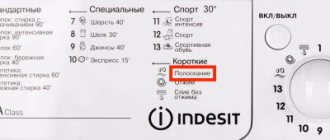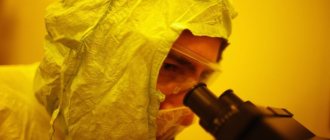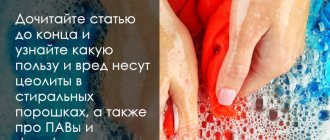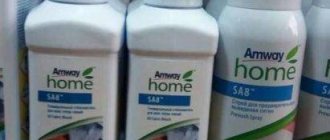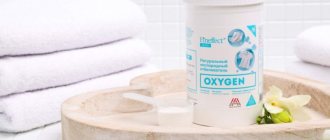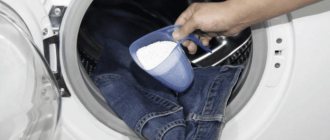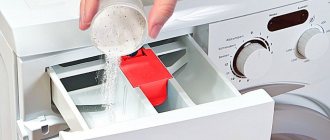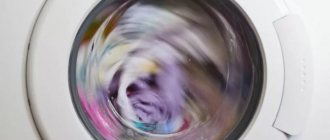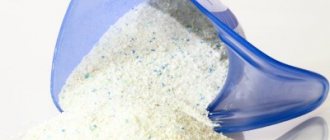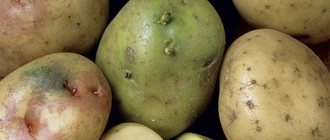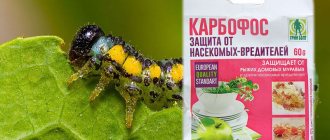It’s a pity, but snow-white T-shirts, tablecloths or bed linen do not delight with their dazzling whiteness for long: within a few months they lose their original appearance, turn yellow and various stains appear on them. Not all housewives know how to return their favorite things to white and which bleach is best suited for a particular type of fabric. Modern household chemicals sometimes work wonders, but they are not always affordable and are used up too quickly. Let's try to figure out which bleach is best to use and how to make a good product yourself at home.
What is the most effective laundry bleach?
Advances in the field of household chemicals allow modern housewives to choose the most suitable means for whitening clothes. Today, you can bleach an item that has lost its original appearance using:
- oxygen bleaches;
- optical means;
- chlorine-containing bleaches;
- homemade whitening products.
All types have their advantages and disadvantages, so it is often necessary to use different means to give products a snow-white appearance. What are the different whitening products, and what are their advantages and disadvantages?
Attention to phosphates
Phosphorus compounds have an extremely negative effect on the condition of human skin - this theory has already been proven by various scientists and researchers. Such substances, used in excess, can destroy the natural protection of the skin. As a result of the negative effects of such drugs, the human body can develop:
- Dermatological pathologies, for example, diathesis, dermatitis, etc.
- Allergy
- Metabolism problems
- Respiratory tract lesions
It is worth understanding that phosphorus compounds can easily penetrate the skin into the bloodstream and spread throughout the body. Such components are often found in dishwashing liquids. Their concentration here is small enough to cause burns to the mucous membranes, but your hands should be additionally protected. Always wear gloves when washing dishes. And after washing it should be rinsed thoroughly.
To eliminate the negative effects of various chemicals included in household chemicals, experts recommend ventilating the room during and after cleaning, and washing the floor after washing clothes. You need to choose products that are certified, do not have a strong odor (this point does not apply to chlorine-containing preparations), and are packaged in sealed packaging. The products cannot be mixed with each other, because it is unknown what reaction they may give. To protect yourself, in addition to gloves, you should also use a face mask.
What is oxygen bleach
The appearance of oxygen-containing bleaches on the household products market has made the lives of many women easier - there is no longer a need for long soaking and boiling of products to return them to their former snow-white appearance. And for bleaching synthetic items, such a product is simply a godsend. Available in both liquid and powder form.
Sodium carbonate or sodium carbonate peroxyhydrate is the main active ingredient in oxygen bleaches and stain removers. Dissolving in water, this chemical element breaks down into soda (a famous bleaching agent of our grandmothers) and hydrogen peroxide, which releases active oxygen.
Under its action, the surface of the fabric oxidizes, which allows you to rid the item of stains, yellowness and unpleasant odors. In addition, oxygen bleach has an antibacterial effect and can be used for washing not only white clothes, but also colored ones.
The household chemicals market offers a wide variety of oxygen-containing products:
- BOS Plus Oxi;
- Vanish Oxi Action;
- Soap nuts ECO 2;
- Sarma Active 5 in 1;
- Persol Extra et al.
To distinguish an oxygen stain remover from other types of bleaching products, you should carefully study the packaging - as a rule, the oxygen content is always indicated on it: Oxi, O2, Active, Oxigen, etc.
The main advantages of liquid oxygen-containing products:
- They do not require exposure to high temperatures; they begin to act when soaked or washed at 40 C.
- You can bleach items made from delicate types of fabric (synthetics, wool, silk).
- Do not destroy the structure of the fabric.
- They cope well with old stains.
- Easily remove stains of various origins (grass, sweat, blood, wine, grease).
- Strengthen the effect of detergents.
- Completely rinsed from the surface of the product.
- Eco-friendly and safe when used as intended.
- They do not cause allergic reactions, therefore they are suitable for bleaching children's linen.
The main disadvantage of oxygen bleaches is their high price. Too much product consumption and the need to frequently get rid of stains on clothes force you to spend quite a decent amount on the purchase, which not everyone can afford. Another disadvantage is the short shelf life (about six months).
Powder stain removers begin to act only at high water temperatures (80–90 degrees), but have a longer shelf life (up to 5 years).
Homeenpoisto (Tikkurila)
It is convenient to treat large surfaces with Homeenpoisto from a garden sprayer.
Finnish-made hyperchlorite solution, a leader in its price group. Sold in 1 and 5 liter containers. Among the advantages:
- universal, whitens wood, tiles, concrete and plastered facades;
- eliminates mold and other types of fungus, prevents subsequent infections;
- copes with deep pollution;
- economical (dilution with water in a ratio of 1 to 3 is recommended).
The solution can be applied with a brush or sponge; after treatment it must be rinsed off. The price of a liter package is from 340 rubles.
What is optical brightener
The operating principle of optical brightener, which can also be called fluorescent, is the reflection of light rays. When washing a product, the bleach is not completely rinsed out; its remaining particles create the illusion of whiteness when light hits the clothing.
The prototype of modern optical brighteners was blue, which has been used in all laundries for many decades. In fact, the snow-white appearance of the fabric is achieved not due to its purity, but due to reflective substances and dyes.
It is not easy to buy pure optical brightener in household chemical departments; it is often found in other detergents. All powders for white laundry contain bleaching substances in different proportions. Oxygen stain removers for white laundry also contain an optical option (Vanisn Gold or Vanish Crystal White, K2r, Heitmann Bleaching Agent and others).
Optical brighteners are strictly prohibited for washing children's underwear and clothes.
After washing or soaking items in such a product, things actually look several shades whiter, but this method of achieving a flawless look is fraught with many disadvantages. First of all, an allergic reaction.
Since the optical agent always remains in the fabric, it comes into contact with the skin and can cause allergies. Optical brighteners should never be used to wash children's clothes!
Is it dangerous for the environment?
Scientists are well aware of the toxicity of optical brighteners to aquatic life. These substances also settle on the gills of fish, preventing them from breathing normally. The bulk of water pollution comes from urban wastewater, which contains an incredible amount of household chemicals. As a result of this, living organisms begin to get sick and die, the quality of water and soil deteriorates, and therefore our health - an environmental disaster does not spare anyone!
Chlorine bleaches
Bleach with sodium hypochlorite is an old remedy tested by our great-grandmothers. A typical representative of chlorine bleach is “Whiteness”. Among the main advantages of chlorine-containing products are:
- high efficiency;
- low cost;
- ease of use (does not require boiling);
- good disinfectant properties.
Chlorine-containing bleaches can only be used on cotton and linen items.
But in terms of their effect on fabric structure, chlorine bleaches are much inferior to oxygen bleaches. With frequent use, products quickly wear out, turn yellow and tear. They are used only for cotton or linen fabrics. Another drawback is the unpleasant smell.
Recently, modern chlorine-containing products have appeared with the addition of optical brighteners and surface active substances (ACE Brilliant, Domestos), which makes it possible to achieve a snow-white look even easier and faster.
Surfactant
Surfactants (surfactants) today are found in all cleaning products - soap, washing powders, dish and room cleaners, etc. Why do they clean surfaces so well? They promote the connection of water molecules with fat molecules, so these substances also break down the protective skin fat of a person. According to the standards established by GOST, the protective layer of the skin after using such products should independently restore up to 60% within 4 hours after using the surfactant, but this does not happen.
All surfactants are divided into:
- Anionic surfactants (a-surfactants) are the most soluble in water, cheap, effective and the most harmful to nature and the human body. They can accumulate in significant concentrations in the body.
- Cationic surfactants - they are less harmful and have bactericidal properties.
- Nonionic surfactants - decompose 100%
Anionic surfactants are often contaminated with nitrosamines, which are carcinogenic, and this is not stated on the label. Most modern household chemicals have a high concentration of anionic surfactants; when used frequently and abundantly in everyday life, this leads to:
- severe degreasing and dehydration of the skin, which leads to premature aging
- in combination with phosphates, which promote more intense penetration of a-surfactants through the skin, they are absorbed into the blood, reducing immunity.
- Anionic surfactants accumulate in organs: in the liver - 0.6%, in the brain - 1.9% of the total amount of surfactants exposed to the skin and other organs.
- these substances have a toxic effect: they disrupt the functions of liver cells, which leads to an increase in cholesterol levels and, as a result, increases the risk of heart attacks and strokes; in the lungs they can cause emphysema, hyperemia, and disrupt the transmission of nerve impulses in the central nervous system and peripheral nervous systems.
- the risk of developing allergic reactions increases.
Modern packaging of washing powders - gel capsules - are such bright and pleasant-to-touch packaging that they attract small children, reminiscent of a toy, candy, or juice box. In the United States, 1 child is hospitalized every day for poisoning after exposure to, inhalation or ingestion of such products (see new household hazards for children). Splashing and swallowing the laundry gel capsule causes coughing, choking, conjunctivitis, eye burns, and vomiting in children.
| |
WHITE LIST
|
How to make laundry bleach at home
A large selection of various stain removers for white linen in the store is not a reason to refuse to use old, proven methods of bleaching. Homemade bleach has an undoubted advantage - it is completely safe even for infants and people with sensitive skin or intolerance to chemicals that are present in store-bought bleaches. In addition, homemade remedies are affordable and quite effective. Old proven recipes will help return crystal whiteness to clothes made of any type of fabric:
- Mix a tablespoon of ammonia with 3 tablespoons of salt and 5 tablespoons of hydrogen peroxide. You can add this mixture to regular washing powder, dissolve it in water and soak white clothes in it for several hours.
- Mix half a glass of table salt with a tablespoon of potato starch, a teaspoon of citric acid and a quarter of a crushed piece of laundry soap. Add 2 liters of warm water and soak for 12–14 hours or overnight.
- Dissolve several crystals of potassium permanganate in a small amount of water. After they are completely dissolved, add them to a basin with 2 liters of hot water. Soak white items in potassium permanganate for at least 12 hours.
Regular aspirin has good whitening properties.
Natural powders
The toxicity of chemical washing powders is widely known and proven. People who do not accept the use of hazardous substances in everyday life are looking for alternatives to toxic detergents. Contrary to popular belief, natural washing powders are not the privilege of the rich. They are quite affordable.
The difference between bio-powders and classic ones is that manufacturers try to replace toxic substances with harmless analogues without harming the cleaning properties of the product. Instead of anionic surfactants, biological ones are introduced. They are extracted from coconut and palm oil or from wheat, rice, potatoes and other natural products.
The quality of washing does not suffer with such a replacement, but the harm to humans and their environment is neutralized. All frequently used bleaches are replaced by auxiliary and nonionic surfactants.
Expert opinion
Irina. Housewife.
Ask a Question
For better washing results, an additional stabilizer of peroxide compounds and an organic complexing agent are added to the environmentally friendly powder. Harmful phosphates are excluded from the composition, and their function of softening water in eco-powder is performed by sodium disilicate. To give washed clothes a pleasant smell, instead of chemical fragrances, the composition contains essential oil.
Washing powder MaKo Clean “Universal”
Aspirin as a laundry bleach
Acetylsalicylic acid tablets help quickly and effectively remove stains from blood, sweat or urine (of protein origin). To do this, dissolve 3 tablets of regular aspirin in half a glass of water and apply the solution to contaminated areas of clothing. After 2-3 hours, not a trace will remain of the stains, and things will become snow-white again.
For old stains, use a concentrated aspirin solution. Take a pack of tablets (10 pieces) with half a glass of water, crush them into powder and apply to the stains, leaving for 30 minutes.
Surfactants
This is the main thing in washing powder, because it is thanks to them that the powder is actually washing) Surfactants are different, and as a rule, a mixture of them is used in one product.
The most common are anionic surfactants; unfortunately, they are the most harmful. But, as you probably already guessed, they are also the most effective. They form a lush foam, which consumers love.
It is important to understand that A-surfactants (A for Anionic) tend to accumulate in the body and, over time, disrupt the integrity of cells, interfere with metabolism and even affect internal organs. Not to mention allergies and dermatitis.
According to European standards, the maximum permissible content of A-surfactants in a product cannot exceed 7%.
But nonionic surfactants completely decompose when released into the environment and are considered practically harmless to humans. But they lather worse and do not wash as effectively. However, responsible manufacturers prefer to use them. Stains are stains, but health comes first!
Tensides are another name for surfactants, which, apparently, are used to make the composition on the label look prettier) A-Tensides are still the same bad guys A-surfactants.
Bleach for baby clothes
Children's clothes can be whitened with home remedies or aspirin. An effective way to return diapers and onesies to their original appearance is to boil the products in 5 liters of boiling water with the addition of a third of a bar of grated laundry soap and 2 tablespoons of baking soda.
Industrial bleaches are not all suitable for whitening children's linen. Especially designed for this:
- powdered product “Eared nanny”;
- Cotico stain remover;
- "Nanny Universal";
- Baby Spesi bleach.
These products do not contain chlorine or optical brighteners, so they do not cause irritation to children's skin and are suitable for frequent use.
To summarize, the best laundry bleach is liquid oxygen stain removers. They can be used for any type of fabric, white and colored items and children's underwear. They do not destroy the fabric structure even with frequent washing and rarely cause skin irritation or allergic reactions. You may pay a high price for high quality, but if oxygen bleach is beyond your means, you can always use homemade formulations that you prepare yourself. They are no less effective, but are affordable for every housewife.
Range
Some types of detergents are positioned as universal for two or three types of cleansing (3 in 1, 2 in 1). A product called “Myth” from Procter & Gamble, according to the manufacturer, is suitable for removing stains from clothes, washing dishes and cleaning tile surfaces. The consumer must understand that bleaching delicate terry cloth and removing plaque from bath enamel are completely different tasks. The components of modern powder, although they have a versatile effect, are not able to cope with two multidirectional actions at the same time. A powder that can make tiles shine can damage thin fabric.
An excellent marketing ploy is to create a specific powder for equipment from a specific manufacturer. For example, Ariel automatic washing powder, according to the manufacturer’s instructions, is optimally suited for Bosh and Siemens washing machines. Perhaps there is still some truth in such “recommendations”, but a comparison of the composition with a competing analogue shows that there are no significant differences between the content of chemical substances in it.
It is extremely difficult for domestic manufacturers to compete with already promoted brands. The largest Russian concern "NEFIS" produces more than 300 items of goods under well-known trademarks - "Lesnaya Polyanka", "Biolan", "AOS", "BiMax", "Sorti", etc. At the same time, many Russian companies are coming under the control of foreign representative offices . Large chemical plants such as Era-Tosno, Northern Lights and Novomoskovskbytkhim were purchased by investors. The products they produced were “transformed” to suit imported equipment and the tastes of European consumers. According to the consulting agency CREON, there are about 65 powder production factories in Russia, and the demand for “small” scale brands is only growing
Domestic brands are “cautiously” squeezing out transnational analogues. For example, the Stupinsky chemical plant, widely known in Soviet times, which produces goods in the mid-price segment, was able to win 0.5% of the market (the “5 plus” line).
Most of the powders that are produced in Russia are examples of “dry mixing”. International developments find their application in domestic realities. Between an expensive powder and a middle-class powder, there is a difference in “promotion”, less often in the content of active substances and so-called ballast. For example, the already mentioned “5 plus” product from the Stupinsky plant contains 25 active components, while Tide has only 11. Mainly Russian factories produce lower segment products with a price accessible to the masses (“Zifa”, “Vesna” and etc.). A representative of the expensive segment is BiMax powder from the NEFIS concern. But “affordable” does not mean “bad” - the effectiveness and quality of domestically produced products are confirmed by GOST 25644-96 (for synthetic powdered products). Liquid washing gels in Russia are produced only by transnational concerns.
About 80% of the market for powder products used by consumers is occupied by foreign brands, and only 20% of domestically produced products enjoy the well-deserved love of Russians. Among them the most popular are:
- Procter & Gamble is an American transnational giant that produces products under the brands Tide, Ariel, Tix, Dreft, and Myth. The profit of the corporation, which occupies 44% of the industry, is more than $3 billion per year (and this is only for the Russian consumer);
- Henkel is a German chemical concern that produces products under the brands Persil, Losk, Deni, Laska and Pemos. Henkel holds 26% of the Russian market share;
- JSC Nefis Cosmetics is a Russian industrial company that owns 10% of the detergent market;
- Reckitt Benckiser is a multinational brand that produces products in the affordable price segment - Dosia, Lanza. Occupies about 7% of the total share;
- OJSC Soda is a Russian brand that holds 5% of the market under the Zifa trademarks and the new environmental innovation Ekol;
- CJSC Aist is a Russian enterprise occupying 4% of the market niche. Produces powders under the brands Aist, Cashmere, Kapel, Yat and Lumix;
- OJSC Nevskaya Kosmetika is a domestic manufacturer of baby powder, which holds 4% of the market. Known under the trademarks Ushasty Nyan, Sarma, Lotus, Max, Index, etc.
Approximately every fourth respondent is influenced by advertising content when choosing a product. Perhaps the low share of popularity among consumers of Russian detergents is explained by the “stingy” strategy of the mass media and their insufficient representation in retail chains.
